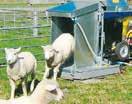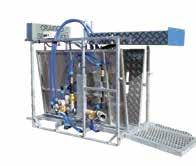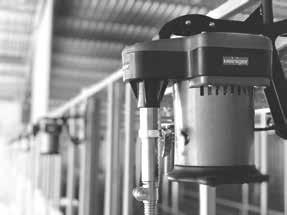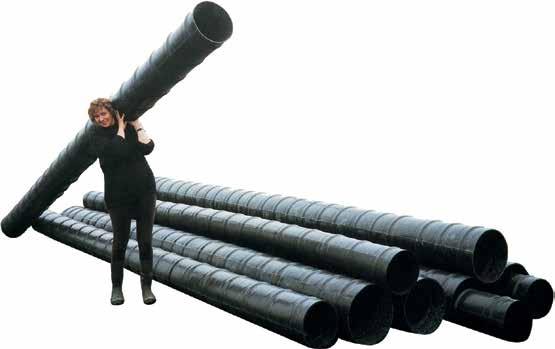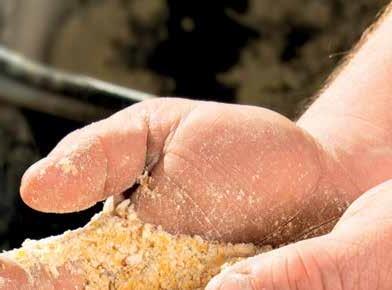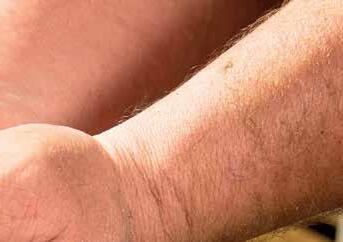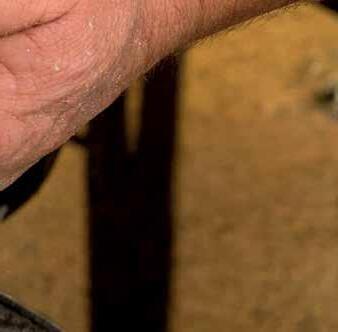
ANIMAL HEALTH
Women ‘dominate vet profession’. PAGE 16

MACHINERY & PRODUCTS
Series 2 multi-feeder wagon more reliable, user friendly.
PAGE 17


Women ‘dominate vet profession’. PAGE 16

Series 2 multi-feeder wagon more reliable, user friendly.
PAGE 17
Still picking up the

“Right now, it’s hard for farmers and it’s hard for Alliance,” Williams told Rural News
MEAT PROCESSOR Alliance Group’s cash-strapped farmer shareholders face a dilemma – either pour more money into the co-operative or risk losing 100% ownership and control.
Alliance needs more capital to strengthen its balance sheet, lift efficiency and pursue additional ‘value capture’ opportunities. However, weak lamb prices mean many sheep farmers are struggling to make ends meet, so forking out extra capital for the co-op will be a tough ask.
Farmer shareholders will hear Alliance’s plans in the coming weeks.
Chief executive Willie Wiese says ultimately the future of Alliance Group as a co-operative depends on how shareholders respond to their capital raise.
“If farmers wish Alliance to stay a 100% farmer-owned co-operative, the only way that can happen is if shareholders contribute,” Wiese told Rural News
“We will be talking to farmers about the capital raise over the coming weeks. It is too early to speculate on other options until we have completed this process.”
Federated Farmers meat and wool section chair Toby Williams says Alliance’s call for more shareholder capital is tantamount to asking farmers to take bread off their own tables to keep the company afloat.
He says not many Alliance shareholders would be able to pump more capital into the company.
“For farmers, it’s a tough situation, making sure we are paid, and our workers are paid. Alliance is asking farmers to take bread off their own tables to keep the company afloat.”
Williams believes it is highly unlikely that Alliance will be forced to sell a stake to an outside investor as was the case with rival meat processor Silver Fern Farms.
“There’s always a possibility but it’s highly likely; for the investor market, buying a share in Alliance is not a palatable affair right now.”
For the year ending September 2023, Alliance Group posted a pre-tax loss of $98 million, a dramatic reversal from the previous year’s record $116m profit. Alliance blamed significant volatility due to geo-political tensions, labour constraints, inflationary pressures and weakening global markets for the shock result.
Wiese says farmers are of course disappointed and that’s understandable.
“Times are tough on farm, so this is certainly not an ideal time to ask farmers for capital. A number of farmers I have spoken with appreciate the challenging situation we are in. They accept we are exploring all other viable opportunities to reduce working capital and they support Alliance remaining a co-operative.”
Alliance’s new chair Mark Wynne points out that New Zealand’s red meat sector has been impacted by weaker global market prices.

“Farmers, processing companies and the agribusiness industry in general are facing significant financial pressure. Alliance Group is no exception.
“Our current trading position and forecast indicates we will make a modest profit this fiscal year, which will be a significant turnaround from our loss last year. This is in line with our financial performance over the last decade where Alliance has been profitable for nine of the last 10 years.
“Over the last 12 months, in particular, we have had a relentless focus on cost reduction, optimising market pricing and inventory in order to reduce our working capital requirements. We’ve made good progress on all fronts.
“However, as signalled at the cooperative’s annual meeting last year, we do need to raise capital from our farmer-shareholders,” Wynne says.

ASSOCIATE AGRICULTURE Minister Andrew Hoggard drew many stares and was the butt of a few jokes when he fronted up to the woolshed roadshow at Fordell, near Whanganui recently with a patch over his right eye. But it was no joke and for him and it’s been a couple of challenging weeks since it was discovered that he had a detached retina initially injured in a rugby game 20 years ago. In a matter of days, he was rushed to a specialist and had the eye operated on, hence the patch.
“Hopefully patched not too much longer, but just long enough for jokes and memes,” he told Rural News
More from the woolshed meeting on p 6.




Now includes 15, 20 & 25mm Adaptors in Superflo Standard Adaptor Pack
The Hansen Superflo Valve has been design and built from the ground up to produce a High Performance Super Low Maintenance Valve. With it’s proven success it’s not difficult to see why so many farmers have embraced it. High Performance 188 L/min @

Slipper Fit Piston Helps Eliminate Stuck Valves




Multiple Size Options
Threaded Outlet for Portables, Washdown, Tanks, Irrigation


HAND TESTED

NEWS 1-10
11
EDNA 12
12
12-14
15 ANIMAL HEALTH 16 MACHINERY AND PRODUCTS 17-18
RURAL TRADER 19
HEAD OFFICE
Lower Ground Floor, 29 Northcroft Street, Takapuna, Auckland 0622
Phone: 09-307 0399
Fax: 09-307 0122
POSTAL ADDRESS
PO Box 331100, Takapuna, Auckland 0740
Published by: Rural News Group
Printed by: Inkwise NZ Ltd
CONTACTS
Editorial:
editor@ruralnews.co.nz
Advertising material: davef@ruralnews.co.nz
Rural News online: www.ruralnews.co.nz
Subscriptions: subsrndn@ruralnews.co.nz
SUDESH KISSUN
sudeshk@ruralnews.co.nz
INCOMING SILVER Fern Farms chair
and King Country farmer Anna Nelson wants the future of farming and rural communities to be thriving, healthy and happy.
The King Country sheep and beef farmer feels that right now rural communities are being decimated by land use changes and economic challenges. The red meat sector has its own problems with lamb prices subdued.
Nelson, who takes over as SFF chair at its annual meeting this week, told Rural News that she cares about rural communities and the future of farming families, and it’s a big part of her new role.
She runs a 1450ha breeding and finishing block in Aria with husband Blair – running 4000 ewes, 300 beef breeding cows and 750 finishing cattle, mostly Friesian bulls. Their three teenage children, who are either at Lincoln University or shepherding in North Otago, are all keen to go into livestock farming.

Nelson says the children are a big part of why she’s doing the role.
“Because I really want the future of farming and the rural communities, they will live in to be thriving, healthy and happy places. Right now, what’s happening in our sheep and beef sector that’s not a given.
“We need to take a look at what we’ve been doing and what we can do
better in the future – the part that we have to do differently is to work more closely together right across the industry.”
Nelson joined the SFF board in October 2021 as a board-appointed director. She successfully contested the director election last year and is now a farmer-elected director.
When she first joined the board,
the chair’s role was not something she was thinking about. But over the last 12 months, she has been groomed to take over as co-op chair.
Nelson is originally from Cheviot and has a veterinary degree from Massey University. As well as 10 years at a vet practice in Waikato, she has also been an associate director at Beef + Lamb NZ and a catchment coordinator at King Country River Care.
She says the co-operative aligns with her family’s values of caring for the land, people, and community.
“I want to make sure that future generations have similar opportunities to work and live rurally, just as I have been lucky enough to do,” she says.
“The broader outlook for the red meat sector is positive, but we’re facing into some difficult challenges at the moment. Land use change, workforce shortages, and logistics challenges all threaten to distract us away from our core focus of delivering high-quality produce into market.
In May next year Nelson will also take over the chairmanship of Silver Fern Farms Limited.
JESSICA MARSHALL
jessica@ruralnews.co.nz
THE DEER industry is working on getting more venison into Asia.
A delegation from Deer Industry New Zealand (DINZ) recently brought a taste of New Zealand venison to China and South Korea to gain more space for the meat on Asian menus.
The delegation included DINZ executive chair Mandy Bell, and exec-
utive chef Graham Brown, who created special dinners showcasing deer industry products.
While the region is more associated with exports of velvet, venison is starting to take off in China.
By 2023, the country grew to be New Zealand’s second-largest market for venison by value, after the United States.
Bell says the trip was “very good”, adding that there were three specific focuses for it: velvet, venison, and a
showcase of New Zealand’s export products.
“We had a fantastic reception at an evening event at the Ritz and had 30 really well-connected chefs and distributors from around Shanghai,” Bell told Rural News
She says that while the event was small, it was fantastic to have a chef like Graham Brown show people how to utilise venison and incorporate it into the cuisine of that market.
“He had several days working with
chefs before the showcase and then we had the special dinner and we had two other chefs that also joined up,” Bell explains.
She says that New Zealand’s venison industry currently doesn’t have any real competitors in the Chinese market.
“That’s why going over to China and South Korea was particularly interesting,” she says.

A GROUP set up to boost education and promotion of wool says it has made positive strides during the first year of its threeyear strategy.
Campaign for Wool New Zealand says, although it’s been demanding, it has seen remarkable growth and got solid traction.
In its 2023 report, released last week, president Ryan Cosgrove says their strategic focus over the last financial year has been unwaveringly centred on their key priorities: education, promotion and advocacy.
“Not only are we confident in the strength and momentum of our strategy, we’re on target and extremely excited about taking our work to the next level in 2024. Our results speak for themselves.
“Thousands of children taught about the wonders of wool with refurbished facilities and resources.
“Over two million people reached with a new multimedia consumer campaign about choosing wool over synthetics.
“We’ve increased our alignment and support with over 230 supporters and partners and we’ve advocated regionally and globally for amplified use of New Zealand wool.”
But Cosgrove says their work is more than a strategy.
“It’s a movement and it’s gathering speed: our actions, and our work alongside our partners is now beginning to create the change the industry needs. And the year ahead will see us do even more.”
According to the

annual report, over two million NZ consumers were reached with multi-channel advertising campaigns across TV, print, radio, digital and social media. The “Wool
in Schools” programme reached 6700 students and it posted 320 “engaging” social media posts across Facebook, LinkedIn and Instagram.
Cosgrove says educat-
ing New Zealand’s youth about the advantages of choosing wool products over synthetic alternatives is vital for instilling early awareness and fostering sustainable habits.
“Primary school years form a crucial foundation for lifelong values, making it an opportune time to introduce concepts of wool performance and environmental responsibility.
While integrating wool education into secondary schools empowers the next generation to prioritise wool use over synthetics, it also develops conscious consumerism and the importance of supporting our nation’s wool industry.
“By teaching young children about the benefits of New Zealand wool, educators can impart essential knowledge about the material’s renewable and biodegradable nature. This early understanding encourages children to develop a sense of responsibility towards the environment, as they grasp the positive
impact of choosing wool over synthetic materials on ecosystems and sustainability.”
He says plans for this year include expanding into tertiary with a tailored modular pilot programme across architecture, and creating a new ‘Wool in Schools’ pilot programme for remote schools.
There are also plans to develop further consumer campaigns to promote wool’s benefits and champion strong wool for specification in public and government buildings.
Initiated in 2010 by King Charles III, the Campaign for Wool (CFW) is a global endeavour raising awareness among consumers about the natural, renewable and biodegradable benefits offered by the fibre.

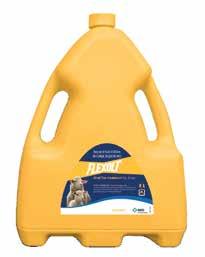

rural areas at a disadvantage, particularly where it limits (and potentially discourages) their participation.
RURAL WOMEN New Zealand (RWNZ) says access to personal banking services in rural communities is fundamental to promoting outcomes that benefit Kiwi consumers.
In a submission to the Commerce Commission after the release of its draft report on the Market Study into Personal Banking Services, RWNZ says the closure of physical branches in rural communities has impacted and even discouraged customers’ service switching behaviours.
“Access to face-to-face services is an important criterion in comparing service options and potentially for consumers in selecting a transaction account that best meets their needs,” the submission says.
The market study was commissioned in June last year, looking at whether competition for personal banking services in New Zealand works well and what can be done to improve it.
The draft report, released earlier this year, found that a reduction in the number of physical branches can lead to greater financial exclusion because of numerous factors, including time and travel costs to get to the nearest bank branch, lack of reliable internet and mobile coverage in some rural areas, and the requirement for sound digital literacy.
In its submission, RWNZ asserts that internet and mobile coverage’s reliability and capacity is inconsistent across New Zealand.
“This inconsistency puts people in
“Moves to digitise personal banking services (such as moves to increase use of internet banking and mobile apps) will need to take account of connectivity issues for rural consumers to ensure they are not excluded by such changes.”
ASB head of rural banking Aidan Gent says that currently over 90% of the bank’s rural customers bank digitally.
“So, the number of people, as opposed to two or three years ago, is significantly lower,” he told Rural News, adding that there are many more things that can be done online than previously.
He says that rural broadband products like Starlink have made the internet “a lot more accessible”.
“Five years ago, I’d have said it was a lot more challenging,” he adds.
Commerce Commission chair John Small says many of the issues it identified in the market study are systemic so its draft recommendations aren’t “quick fixes”. Instead, based on the recommendations, the Commission would expect to see sustained improvements over time.
“Ultimately, we want New Zealanders to be better off and confident that they are getting great value, clear choices, and innovative offerings in their banking services,” Small says.
Consultation for the Draft Report has now closed, with a final report due for publication in August 2024.
A SOUTHLAND farming leader wants the regional council to delay a proposed regional rates hike, much of which is intended to fund flood protection works.
Under its proposed Long-Term Plan (LTP), Environment Southland (ES) envisages about a 23% increase in regional rates, but Hugh Gardyne, chair of the Mataura Catchment Liaison Committee (MCLC), says farmers simply can’t afford it.
“From a farmer and a ratepayer’s perspective, at the present time, the things that we can’t control are interest rates, insurance, and rates.
“But be under no misunderstanding. Farmers are desperate to cut costs down, to hopefully achieve a cash surplus for

the year. It’s very difficult,” Gardyne told Rural News
The council’s figures show the rate increase is made up of 9% for flood infrastructure, 5% for flood infrastructure investment and 9% for council services.
Gardyne says farmers would stomach the inflation part of the rates increase – about 4.5% –
but much of it was down to the proposed flood protection measures.
“It’s that portion that I’m saying, ‘look have a spell, consult a bit wider, get people to understand more what’s happening’.”
ES says ongoing and greater investment in flood protection is a key proposal of the LTP. A proposed new Flood Protection Infrastructure
Rate, based on property capital value, would replace 140 existing catchment rates.
Gardyne said the flood risk from climate change was over-hyped.
“It’s coming out of places like NIWA, it’s coming out of the National Policy Statements and whatnot.
“People need to just get a grip because we can only afford what we can afford,” he said.
However, ES chair Nicol Horrell says the council had to consider recent big events such as Cyclone Gabrielle and past Southland floods.
He said he could not comment on the LTP in detail while the consultation was underway but there had been a good crowd at a public meeting in Invercargill on April 29 and he implored people to make a submission.

‘A LOT of interest and positive responses’ appears to be the way farmers are viewing the Government’s initiative to hold a series of woolshed meetings around the country.
One such event was held recently on a farm at Fordell, just south of Whanganui, where nearly 100 people turned up to hear the Associate Minister of Agriculture Andrew Hoggard and two local MPs, Suze Redmayne and Carl Bates, explain the purpose of the meetings.
The actual stage for the speakers was very rural – a loading ramp beside the woolshed from which they could easily be seen and mostly heard by the gathering of farmers from around the district.
Hoggard says the meeting was a good chance to meet farmers, discuss what the new government intended to do and to get feedback from farmers on what they see
AT THE Fordel meeting, issues raised included the cost of interest rates, water storage, regulations, climate change, the protection of highly productive land, concern about the viability of hill country farms and of course wool.
Local farmer Tim Mathews says he was surprised at the good turnout and praised the agenda of the new Government. He mentioned the high rates bills he now faces, from both the district and regional councils, which he says is making it hard to make a buck.
“It’s a pretty ugly and tough year for sheep and beef farmers,” he says.
Former Beef + Lamb NZ director Kirsten Bryant who farms locally says she was encouraged by the commonsense approach the Government is taking at this initial stage and trying to make farming easier.
“We have been struggling under this weight of regulation that just seems to be layer upon layer and a lot of it didn’t make sense. The way the system was evolving was a bit of a barrier to innovation,” she says.
Bryant says the solution to many problems rely on an innovative as opposed to a prescriptive approach, because no one land parcel is the same. She says 99% of the time farmers will figure out a practical solution to a problem.
as their big concerns.
“I have been to a number of these meetings and I have found them really useful in terms of understanding what the big issues are for farmers,” he says.
World’s most powerful variable speed clipper is here!

MAKE DIRTY JOBS EASY THIS SEASON
■ Ideal for shearing sheep, alpacas, goats and cow tail.
■ Variable speed from 2600-3500rpm.
■ Latest brushless motor technology means minimal heat build up
■ 1400gms means 100-200gms lighter than standard handpiece
■ At 2800rpm the 12v lithium battery will trim up to 400-500 cows tails or crutch 300-400 sheep
■ Tough alloy switch box with auto rest fuse for overload or lockup – clips to belt.
GET YOUR REPAIRS & SERVICE DONE ASAP!
View in action go to www.handypiece.co.nz
Freephone 0800 474 327
email: dave@handypiece.co.nz

He says wool has predictably been an issue, along with hearing about some of the absurdities of impractical and costly regulations. He says in
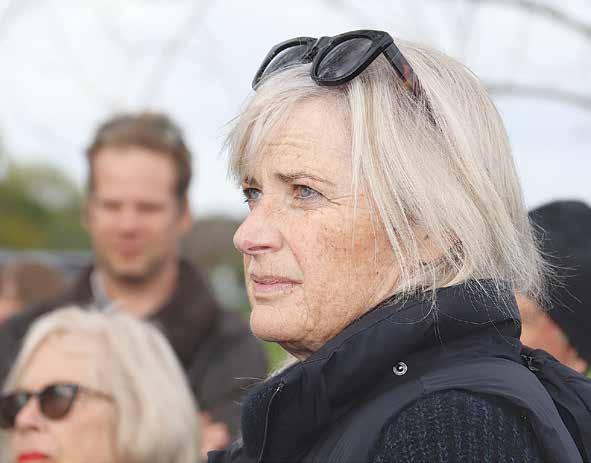
Taranaki, a farmer was faced with having to put in 250km of fencing to protect waterways on a 500ha farm.
In the end the farmer sold the property to for-
estry interests because the cost of complying with the regional council demands was uneconomic.
On the issue of wool, Hoggard says the situa-
LESS WELLINGTON bureaucracy and more local, on-farm common sense was the focus of recent meetings in held in South Canterbury as part of the Government’s National Woolshed tour program.
The two meetings, one at Waihaorunga and one at Albury, were hosted by Minister for Rural Communities Mark Patterson and MP for Waitaki Miles Anderson, attracting over 40 farmers at each event.
Patterson outlined the Government’s aim to support the wool industry in these dire times, while also allowing it to grow beyond what it was capable of beforehand.
“There’s been a global swing to natural fibres. Some smart entrepreneurs are doing some very interesting things, such as 3D printing biodegradable acoustic wall panels.
“We absolutely need wool prices to lift, especially as a support when meat prices run low.
If there’s a hill to die on, there are less worthy ones than wool.”
Patterson said that the previous government “had been too Wellington-centric”, ignoring the provinces that make up significant portions of New Zealand’s population and economy.
Anderson said that while the original Resource Management Act had local input, he felt that outside non-government organisations had become too influential on policy matters. “I don’t think outside organisations should be given more standing than local knowledge.”
The announcement that the Government would be repealing intensive winter grazing regulations and amending the ‘10 degrees’ low slope law drew much applause from the crowd.
“We’ve seen farmers lift their game about winter grazing over the last 3-4 years,” said Patterson. “It’s a high trust model.”
Nevertheless, Anderson and Patterson said there was still a lot of work to do to get regulations up to standard for farmers.
Anderson points to changes in the nation’s gun laws, passed
tion is weird with people going on about having sustainable products and loving the environment.
“Yet what does everyone do? Buy synthetics.
“So, what the hell is
in the wake of the Christchurch mas sacre that, combined with lost hunt ing seasons in 2020-21 due to Covid, have seen pest spe cies popula tions explode across the country.
“Meanwhile, wild ing pines planted to capture carbon cred its have overtaken native plants and, ironically, by disturbing the native environ ment they have actually increased greenhouse gas emissions.”
going on when all the messaging is about natural and yet the reality is the natural is going out of business and synthetics are ruling the roost,” he says.

Some topics divided the room, however, with live exports
and gene editing sparking fierce debate between attendees and the representatives, with those in support being matched by those against. Patterson, speaking in support of live exports, said that regardless of personal views on the issue, it was imperative that New Zealand adopt models to ensure that farmers can continue to have reliable income over different governments.
“We need the primary sector humming. We can’t afford to turn down opportunities. We want to analyse the latest science and review. It’s not going to be a quick fix, but we can make it work.” – Leo Argent
THE EUROPEAN Union
Ambassador says the new free trade agreement (FTA) between the bloc and New Zealand will bring significant benefits to both parties.
Lawrence Meredith told Rural News that one of his goals is to get out and talk to farmers about the deal and explain the benefits.
The FTA came into effect last week and will see duties removed on 91% of NZ exports to the EU, immediately rising to 97% over seven years.
Two of the big beneficiaries of the deal are kiwifruit growers who can expect savings of around $16,000 this year with the removal of tariffs, and onion growers can expect to see annual industry savings of around $6.5
LAWRENCE MEREDITH grew up in a dairy farming village in Yorkshire in England and has a great empathy with the people who work the land and the essential role they play in their own communities and wider society.
“I want to get out of Wellington and to hear the voice of NZ farmers, even though it is unlikely that we’ll agree on every aspect of the FTA. But I think we should have this conversation and there are new opportunities with this trade agreement for farmers,” he says.
Meredith says he’s aware that NZ farmers had hoped for more in a NZ-EU FTA, but says it is still a very good deal and has long term benefits.
“A trade agreement is a piece of paper. What I am interested in doing is turning this into real business deals where farmers make more profits on both sides. There are gains to be had for all in this FTA.”
million. There are also small increases in quota for beef, sheepmeat and dairy products. Overall, the NZ-EU FTA is expected to increase total NZ exports to the EU by $1.8 billion annually.
Meredith says as well as trade, the FTA rein-
forces the very strong shared values of the partners in the agreement.
He says NZ’s strong support for Ukraine aligns with the EU’s stance on what he describes as the brutal and illegal invasion of Ukraine.
He says there are

also strong cultural and historical connections between NZ and many EU members, including the Netherlands, Poland, Croatia and Ireland – the latter being where his own ancestors came.
“This trade agreement has achieved the highest approval rating of any trade agreement in EU history for two impor-
tant reasons. Firstly, it has a strong and innovative chapter on sustainable development, and secondly, we have the world’s first specific chapter for relations with Māori and Māori business,” he says.
Meredith says the other big benefit for NZ is that it will now have access to a very extensive
Pour On is
and well-funded research programme called Horizon Europe. He says NZ is the first global partner of this programme outside of Europe and says our scientists have a high success rate in applying for grants.
While NZ will benefit from the FTA in trading terms, the EU, says Meredith, is seeing big
opportunities in terms of potential investment in climate tech, agritech, digital and more broadly infrastructure.
“My role here is to work with my fellow European ambassadors based in Wellington and those based in Canberra to do everything possible to strengthen the trading ties with NZ,” he says.
While NZ is strongly supportive of the EU in respect of the war in Ukraine, the EU is looking to NZ to develop closer links with the Pacific region.
Meredith says NZ is seen as a leader in this area and notes the region is rapidly growing in importance in both geopolitical and trading terms. He says there is great opportunity for both parties to broaden their relationship in the region.

When you choose TURBO* Pour On, you’re not only getting the ultimate solution for parasite control you’re also receiving a cutting-edge tool to enhance your work productivity. The Metabo SSE 18 LTX BL Compact Cordless Sabre Saw is a valuable tool for farm operations, offering convenience, versatility, efficiency, precision, and safety.
AND



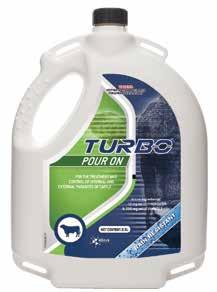
FEELING FORGOTTEN
and in a fragile space financially and mentally.
That’s how Toby Williams, Federated Farmers meat and wool group chair and national board member, who farms near Gisborne, describes the state of farmers in Tairāwhiti and northern Hawke’s Bay.
He says it will take some farmers between five and ten years and cost up to $2million to get their properties back to where they were before Cyclone Gabrielle and a succession of other rain events struck the regions.
He says right now farmers are feeling the pinch financially, their wallets are locked away and they are only spending on essential items.
Williams himself is based near the settlement of Whangara, about 30 minutes drive north of Gisborne up State Highway 2. He winters 13,000 stock units on his medium steep hill country property. They run about 400 heifers and cows, lamb 3500 ewes and 1000 hoggets, all finished on the farm.
His family are well known in the district and in the last few years he and his brother completed a deal with the family for them to run their own farms.
He came back to farming after completing a degree in economics at Canterbury University and has been on the present farm for the past eleven years.
“We had over three metres of rain through (cyclones) Hale and Gabrielle last year and our annual rainfall is about 1200mm – so it’s triple the average rainfall. But you can almost go back to 2018 and the Queen’s Birthday floods at Tolaga Bay which hit us here at Whangara. That event didn’t hit the whole district and believe it or not, at the time, half of Gisborne was enduring a crippling drought,” he says.
Williams says most of the rain events didn’t make the national news,
but for example, he was hit by a huge storm that came right before weaning and it took out huge chunks of land.
“For us that was bigger than Gabrielle and Hale. But then two weeks after Gabrielle we had another 300 or 400mm over the next weekend, which didn’t get media attention, and more rain kept coming in June and July accentuating the damage,” he says.
Driving around William’s farm, there is plenty of evidence of the damage caused by the rain, and his property is far from the worst in the region. Slips are everywhere and temporary fencing is being used because the land is still slipping. Poplar poles are extensively planted around the hills to try and stop the land slipping even more, but that is still a losing battle with mother nature.
“In our case, every

paddock has got some slips, and we have quite strong country. In some ways it’s amazing how well the farm has held together. But the problem is the ongoing slump-
ing of the land, which is waterlogged, and our fences are no longer straight. Our fences run for two or three kilometres – not just a few hundred metres,” he says.
A YEAR on and the problems created by the cyclones has largely dropped off the radar of media and politicians.
As Toby Williams rightly says, the story is no longer ‘sexy’ and the plight of East Coast farmers is largely forgotten. This mirrors concerns expressed recently by Wairoa Mayor Craig Little about the slow progress in repairing SH2 south of his town.
Back on the farms, the problem of repairing damaged fences is not just about still-moving hillsides. The sheep and beef sector is experiencing one of its all time lows with lamb prices down and input costs up. Beef+Lamb NZ is predicting that the best profit that sheep and beef farmers will make this year is around $60,000, but Williams believes that many won’t see that sort of money if they have high debt levels.
He says fencing costs have doubled in the past two years and believes it will cost him in the order of $200,000 to $300,000 to get his farm back to what it was.
“The real challenge is: how do you put your farm together when you have no money? It’s very hard to go farming when your fences leak and when you can’t keep your stock where they need to be. For example, we put a mob of ewes into
a paddock and half of them disappeared and then we pulled 50 ram lambs from a mob of ewes the other day because they got through fences that were damaged overnight by rain,” he says.
With farmers struggling to afford fencing materials, Federated Farmers is organising a fund raising event to so that farmers can get fence posts and wire free of charge. Williams and his team have persuaded Parliament’s netball and rugby team to come to Gisborne on the weekend of May 25 to play a series of matches against Fed Farmers invitational teams to help raise the money.
He says they have sold the sponsorship for the team jerseys and got good deals from local suppliers and fantastic support from FMG and Woolworths NZ, and Feds will pick up the administration costs.
“One hundred percent of the money raised will go on posts and wire,” he says. Williams says he hopes this event, as well as raising money to help needy farmers, will also raise the profile of the problems that still exist on the East Coast and will likely continue for several years. He hopes it will give hope to farmers whose spirits are low.

THE WORLD’S largest wool scouring facility, WoolWork’s Awatoto plant in Napier, is back operating at full capacity.
This follows a $50 million rebuild due to damage caused by Cyclone Gabrielle in February last year.
The cyclone sent twometre high flood waters and silt pouring into the plant, causing major damage to the building, electrical systems, drainage and water infrastructure. A large amount of equipment, including the entire wool sorting operation and scour feed, was destroyed.
WoolWorks president Nigel Hales says Awatoto is the largest wool scouring plant in the country and a very important resource for farmers, the wool sector and the region.
“This re-opening highlights our commitment to New Zealand wool growers, the wool industry, and more broadly the primary sector. It also ensures continued employment for people in the region and ongoing investment at a time when the local and national economy is experiencing headwinds.
“We know wool growers are under pressure

due to the challenging wool prices, however we absolutely believe there is a long-term future for wool.
“We are passionate and committed to wool and believe that our ongoing investment in research and development, processing and manufacturing partnerships will support this unique and special fibre to become more widely accepted and sought after as the world seeks solutions to material problems and makes a commitment to sustainability,” says Hales.
The rebuild has also included a strong focus on future proofing. All main electrical boards are now located over three metres in height, with a 120 minute fire protection rating and, in some
cases, to a force 10 earthquake proof standard.
WoolWorks has an established decarbonisation programme to reduce its emissions and future projects for the site include electricity generation from solar, micro wind turbines and a micro hydro electro generation unit.
Processing annually up to 107 million greasy kilograms of wool, WoolWorks is the largest earlystage wool processor in the world.
While the Napier plant was out of action, WoolWorks’ auxiliary site in nearby Clive, stepped up operations, operating 24/7 while North Island wool was also transported to WoolWorks South Island mega-site in Washdyke, Timaru.
Hales thanked share-
BEEF + LAMB New Zealand chief executive for the past eight years, Sam McIvor is heading for new pastures at Ospri, which runs NZ’s integrated animal disease management and traceability service.
McIvor leaves B+LNZ at the end of July and takes up his new role the following month.
Well-known for his passion and commitment to the primary sector, McIvor grew up on a hill country sheep and beef property in the Manawatū and after leaving school completed an agricultural science at Massey University.
This was the beginning of his career in the primary sector which included on-farm work and various managerial roles in the processing and retail areas. He had a stint as a sheep and beef farm consultant
in Hawke’s Bay before managing procurement of Heinz Watties. He then had various roles at B+LNZ, including research and development manager and product and information transfer manager.
Later he became chief executive of NZ Pork before taking up the role of chief executive of Preston Corp which included overseeing the Export Meat Warehouse chain of stores.
The next move was as group general manager farm operations at Ospri, then in 2016 he became chief executive at B+LNZ, replacing Dr Scott Champion.
McIvor is highly regarded for his wide knowledge right across the primary sector. At B+LNZ he’s led the organisation through some challenging times, including Covid19, the controversial He Eke Waka Noa consultation process and Mycoplasma bovis.
holders, customers, the Ministry for Primary Industries, contractors and staff for their unwavering support.
“This was a challenging situation for the entire industry and we did all we could to utilise all available capacity across the company to keep the flow of wool moving through our available scouring plants.
“With over 85% of the wool we process being exported, we’re supporting logistics and seafreight companies, their people and service providers in and around the Hawke’s Bay and Canterbury regions.”
The company employs 150 people across a wide range of critical operational, technical, engineering, administrative and management roles.
Ospri chair Dr Paul Reynolds says they are thrilled to welcome McIvor.
“His extensive experience, coupled with his profound understanding of the agricultural sector, uniquely positions him to drive Ospri forward and deliver value to our shareholders, stakeholders, and the farming community,” he says.
Meanwhile, B+LNZ chair Kate Acland thanked McIvor and acknowledged the significant contribution he has made to the organisation and the sector in the 17 years he has worked for B+LNZ and the NZ Meat Board, particularly the last eight as CEO.
“We are delighted that Sam has chosen to continue with a role in the agriculture sector and are confident he will continue to make a positive impact on the sector through this position,” says Acland.


“...Collars have been priceless in helping catch issues early.” – Justin Downing, Waikato, 510 cows
“We get a health alert to the app on our phone when a cow’s active minutes are down, or she is not ruminating as much. We can do a quicksort and draft her out when she comes into the shed so we can visually inspect her,” says Justin.
“The system has picked up at least two cows that were having issues that the team wouldn’t have otherwise known.“It meant we were able to get ahead of the issue before it became a real problem. One of them had mastitis which we were able to catch early and treat,” says Justin.
THE LEGACY of Dr
Peter Snow continues to inspire as the recipients of the 2023 and 2024 Peter Snow Memorial Awards were announced at the recent National Rural Health Conference.
Rhoena Davis was honoured with the Peter Snow Memorial Award for 2023 for her exemplary service to Māori health, rural healthcare delivery and nursing leadership.
As chair of the Māori caucus of the College of Nurses Aotearoa and a member of the New Zealand Nursing Council Komiti Māori, Davis has played a pivotal role in shaping nursing leadership and advocating for Māori health at local, regional, and national levels.
Her advocacy for funding and policy changes to support Nurse Practitioners and working tirelessly to address inequities in healthcare delivery, particularly in rural and remote areas, has made her a highly respected figure within the medical community. Davis is involved in various national groups, including the National Nurse Leaders Group, Ora Taiao, and the Federation of Primary Health Care.
Beyond nursing organisations, Davis sits on the Hauora Taiwhenua Board as deputy chair, where her expertise has been influential in shaping the organisation’s foundation. She has also been part of initiatives aimed at actualising the principles of Te Tiriti o Waitangi through her position

as deputy chair of Te Ropu Arahi.
Kyle Eggleton was announced as the recipient of the 2024 Peter Snow Memorial Award, with his contributions reflecting a persistent commitment to improving healthcare access and outcomes for rural communities, embodying the spirit of service and leadership in the healthcare sector.
After graduating with a medical degree from the University of Auckland, Eggleton returned to Northland to work as a rural GP, driven by a deep understanding of the impacts of rurality and social deprivation on community health. His commitment to addressing these disparities led him to join a Māori health provider where he spearheaded
community-led projects focused on improving health equity.
Eventually becoming the Associate Dean (Rural) at Auckland University, Eggleton’s clinical practice informs his academic roles as a teacher for medical and health students and as a researcher leading medical education and rural health projects. Through this role,
Eggleton’s achievements include establishing a rural stream for medical students and implementing admission schemes to professional health programs for rural-origin students. His dedication to rural healthcare extends to designing curricula and interprofessional programs aimed at enhancing healthcare delivery in underserved areas.
The awards were set up to honour the life and work of Tapanui based rural general practitioner Snow, who passed away in March 2006. Influential for raising safety awareness on farming related accidents and contributing to the identification of chronic fatigue syndrome in New Zealand, he was also president of the
A SEMINAR on rural dispute resolution has been organised at Lincoln University, Christchurch this month.
The one-day gathering, taking place on 14 May, will be hosted by the Arbitrators’ and Mediators’ Institute of New Zealand, or AMINZ, the country’s professional association for dispute resolvers.
Valuation disputes, sharemilking agreements and farm ownership structures will be among issues discussed by a group of speakers. Local law firm, Tavendale and Partners, who have a shared goal of promoting effective dispute resolution in the agribusiness sector, are sponsoring the event. AMINZ executive director Monique
Pearson says the seminar is one of an array of similar events hosted by the organisation and is aimed at helping improve dispute resolution and providing continuing professional development across several sectors.
“This particular event is designed to be an insightful and engaging day, focusing on important topics relevant to our rural community,” says Pearson. “The rural sector is our country’s economic backbone, and this is a forum to discuss the many challenges faced in the area of dispute resolution.”
The programme will feature discussions on key areas such as farm debt mediation, rural arbitration,
sharemilking agreements, national panel of conciliators and family succession conflicts. Pearson describes these topics are vital for navigating the complexities of the rural sector and resolving disputes.
Among the confirmed speakers are Federated Farmers national vice president Colin Hurst, lawyer Mark Tavendale, arbitrator Penny Mudford, mediator Ann Skelton, consultant Kim Robinson, former crown prosecutor Ben Vanderkolk, commercial mediator Barry Jordan, agribusiness advisor Guy Polson, commercial litigator Alex MacDuff, James Law, arbitrator Ranald Gordon and Peter Glassford.
Peason says all interested parties
are invited to join in the crucial conversations that impact the rural sector and to contribute to the development of solutions that are tailored to the unique needs of New Zealand’s rural communities. For more information, they can visit the AMINZ website, www.aminz.org.nz.
AMINZ is professional institute in New Zealand for people working in dispute resolution. The Institute is a not-for-profit organisation dedicated to promoting high-quality dispute resolution services by its members to the public.
It has a significant role in the New Zealand Farm Debt Mediation Scheme, established under the
Royal New Zealand College of General Practitioners and a member of the Otago Hospital Board and District Health Board.
Hauora Taiwhenua chair Dr Fiona Bodlen said that they were delighted to recognise Eggleton and Davis for their ‘exceptional’ contributions to rural health.
“Through their remarkable impacts, Rhoena and Kyle have demonstrated that dedication knows no bounds when it comes to serving rural communities. We extend our heartfelt congratulations to them both.”
Despite there being no Conference in 2023 following the disruption of Covid, the decision was made to honour the work of nominees during that time.
Farm Debt Mediation Act 2019, and has been granted the status of an Approved Mediation Organisation by the Ministry for Primary Industries. This accreditation allows AMINZ to oversee and authorise mediators who are competent to conduct these mediations. AMINZ also collaborates in developing and maintaining the standards and training required for mediators under the scheme. The scheme not only helps address the immediate financial disputes but also aims to improve the overall resilience and mental health of the farming community by providing a fair process for handling what can be stressful financial situations.


THE LOW unemployment environment is one of the key factors driving on-farm salaries higher over the past 24 months, says Rabobank general manager for country banking Bruce Weir.
“Many farm owners have found it incredibly difficult to source skilled labour over recent years, and this has played a key role in lifting wages as employers have had to pay more to attract and maintain good staff,” he says.
Another major driver of salary growth – particularly for the dairy sector which has a greater reli-
ance on overseas workers – was the Accredited Employer Work Visa (AEWV), he points out.
“Introduced in mid2022, the AEWV requires employers to pay at least the median wage to international workers as a condition of the visa, and this has lifted pay for international workers higher,” Weir says.
“This in turn has led to increased pay for domestic workers as employers have increased salaries for this group to ensure pay-parity with their international counterparts.”
Weir made the comments after a new report showed farm employers across the dairy, sheep
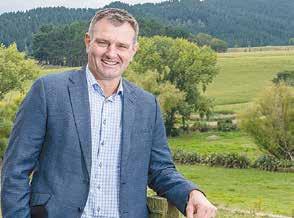
and beef, and arable sectors have continued to invest strongly in one of their greatest assets –their staff.
The 2024 Federated Farmers-Rabobank Farming Salaries Report shows that since the last report in 2022, the average salary for a farm
worker has increased by $7,480 to $71,411 and the weighted average annual salary across the 13 surveyed on-farm position categories has grown by 13%.
“For some more senior roles, the increases have been significantly higher,” Federated Farm-

ers national board member and employment spokesperson Richard McIntyre says.
For example, the average salary for a dairy herd manager is up 19% to $74,185. A sheep/beef farm manager is earning an average 22% more than two years ago ($88,381) and the average income for an arable farm manager is up 28% to $101,264.
McIntyre says the increases are impressive, especially in light of all the headwinds farmers have contended with over the past two years, which have included Covid, severe weather events, production-suffocating red tape, inflation and
roller-coaster commodity prices.
“And these upwards salary movements underline that careers in agriculture are not only satisfying, but also paycompetitive,” he says.
Weir adds that while growth in on-farm salaries increased costs for farm owners, it was crucial to help attract young people into agricultural careers.
“Alongside our client councils, Rabobank is involved in a number of activities that focus on highlighting to secondary school students the array of career opportunities available across the agri sector,” he says.
“We know that remu-
neration is a key consideration for this group when they’re thinking about career pathways and, if we want to attract good young people into the sector, it’s vitally important that growth in salaries for on-farm roles keeps pace with, or exceeds, what is happening across the wider employment market.
“Statistics NZ data tells us that Labour Cost Index wage growth across all New Zealand sectors in the 24 months to December 31 last year was around 11 per cent, so it’s good to see salaries for most of the surveyed on-farm positions growing at this rate or quicker over the same period.”

THE RECENT Federated Farmers / Rabobank 2024 Farming Salaries Report revealed strong growth in farm salaries over the past two years.
The numbers speak for themselves: weighted average salaries rose by 11% for dairy sector roles, by 17% for sheep and beef roles, and by 14% for arable roles.
The increases have come even though the agricultural sector facing a raft of challenges in the past two years – farm owners have been facing higher input costs and interest rates. Despite this, farm employers across the dairy, sheep and beef, and arable sectors have continued to invest strongly in one of their greatest assets – their staff.
Since 2022, the average salary for a farm worker has increased by $7,480 to $71,411 and the weighted average annual salary across the 13 surveyed on-farm position categories has grown by 13%.
And for some more senior roles, the increases have been significantly higher: the average salary for a dairy herd manager is up 19% to $74,185. A sheep/beef farm manager is earning an average 22% more than two years ago ($88,381) and the average income for an arable farm manager is up 28% to $101,264.
As Federated Farmers points out, the increases are impressive, especially considering all the headwinds farmers have contended with over the past two years which have included Covid, severe weather events, production-suffocating red tape, inflation and roller-coaster commodity prices.
The report also highlights strong growth in Total Package Values (TPV) for farm employees. The average TPV for someone working in the sheep and beef sector rose to $76,296, nearly $3,700 more than the salary.
The average weekly hours worked on farms is below the International Labour Organisation’s recommended maximum standard weekly total of 48 hours. The average number of hours worked by a permanent dairy staff member was 46.3 hours. On a sheep and beef farm it was 44.4 hours and on an arable farm 46.3 hours.
These impressive statistics show that NZ agriculture remains an attractive workplace for both locals and migrants, and farm owners are dedicated and fair employers.
Finally, it means careers in NZ agriculture are not only satisfying, but also pay-competitive.
HEAD OFFICE POSTAL ADDRESS:
PO Box 331100, Takapuna, Auckland 0740
Phone 09-307 0399
PUBLISHER: Brian Hight Ph 09 307 0399
GENERAL MANAGER: Adam Fricker Ph 021-842 226
EDITOR: Sudesh Kissun Ph 021-963 177 sudeshk@ruralnews.co.nz

THE HOUND’S reckons school teachers like nothing better than to complain constantly about how tough things are for them and that their generous holidays are all spent ‘marking school work and preparing for next term ahead’. However, a farmer mate of yours truly suggests his recent experience calls these claims into question. This mate was recently in Canada, visiting his son who is currently working on farms in that country. His visit happened to coincide with the first term of the school holidays back in NZ. While in Canada, our hero and his wife decide they would take advantage of that country’s famous snow skiing for a couple of days at the slopes at the Banff Ski Resort in Alberta. Imagine his surprise when they bumped into a group of 200 high school teachers from NZ on a $12,000 (each) two week ski package at the resort. Tough gig!

Want to share your opinion or gossip with the Hound? Send your emails to: hound@ruralnews.co.nz
READERS OF this column will know that your old mate has been a long-time critic of $55 million of taxpayers’ money handed out to ‘favoured’ media outlets via the Public Interest Journalism Fund (PIJF) through NZ on Air by the previous government. He believes this seriously harmed public trust in the media, as evidenced by a recent AUT survey, which showed trust has plummeted by 20 percentage points since 2020. There are also real questions about proper transparency of exactly how the PIJF money was used. For instance, not all media outlets who secured funding appear to have made any acknowledgement of NZ on Air or the PIJF for this taxpayer funding in its publications. Surely there needs to be a proper public audit of the PIJF.
PRODUCTION: David Ferguson Ph 027 272 5372 davef@ruralnews.co.nz
Becky Williams Ph 021 100 4381 beckyw@ruralnews.co.nz
REPORTERS: Peter Burke Ph 021 224 2184 peterb@ruralnews.co.nz
Nigel Malthus Ph 021-164 4258
MACHINERY EDITOR: Mark Daniel Ph 021 906 723 markd@ruralnews.co.nz
YOUR CANINE crusader gets a little fed up with the some in media, union hacks, opposition politicians and hard-core lefty whiners who claim the answer to all the country’s current financial woes is to tax the rich even more. This is despite findings of a research paper by the NZ Treasury, based on data from the fiscal year ending March 2019, that the top 20% of income earners paid most of the taxes. The research found that while Wellington collected over $40b in income taxes from individuals, it was the top 20% of earners who contributed more than 50% of that total amount.
As Professor of Public Policy at Victoria University Arthur Grimes points out, the public might not know, but a small percentage of high-income earners pay the majority of tax revenue, while “most people at the poor end are net recipients from the government”.
AUCKLAND SALES CONTACT: Stephen Pollard Ph 021 963 166 stephenp@ruralnews.co.nz
WAIKATO & WELLINGTON SALES
CONTACT: Lisa Wise Ph 027 369 9218 lisaw@ruralnews.co.nz
THIS OLD mutt well remembers the wailing, whining and gnashing of teeth by former West Coast MP and Labour Agriculture Minister Damian O’Connor when Chineseowned Yili took over the troubled dairy company Westland Milk a few years back. O’Connor claimed it would be end of the world and West Coast dairy farmers would be the losers. However, it seems –like his election result last October – the only loser in this case is O’Connor. The company recently notched up its second impressive annual result in a row, with a 43.7% lift in net profit to $55.9 million in 2023. It was also above 2022’s $38.9m record-breaking result and a $120m rebound from 2021. Since Yili bought the once troubled company in 2019, former shareholder farmers have not only had record profits but also received a cash payment of $3.41 a share and a 10-year guaranteed competitive milk payout.
SOUTH ISLAND SALES CONTACT: Kaye Sutherland Ph 021 221 1994 kayes@ruralnews.co.nz
DIGITAL STRATEGIST: Jessica Marshall Ph 021 0232 6446


QUITE RECENTLY I had an interesting chat with one of our local business owners. They run a garage and vehicle service centre in town.
They provide a great service to our rural community, good people with the support of a good team. When we moved into the area several years ago, other local farmers recommended them to us.
I asked if they had been busy lately, as I recalled not being able to get one of our vehicles in for a warrant before

to slow down enough to listen.
We too are simply all the better for some regular care and ‘maintenance’.
I well remember hearing a speaker, probably 30 years ago, refer to this “burning the candle at both ends” thing. He told us
That’s life, isn’t it.
Of course, for many in our rural sector the mortgage shouts loud when it comes time to divvy up whatever coin is available! Medical expenses
reminded me R & R stands for rest and relaxation. Some go for rest and recreation. I have also heard it put as rest and refreshing. Which is right, you wonder? I’d say, take all three of them!”
Christmas. The answer was yes, they were still very busy, but they were finding it quite different now, to their normal.
They seemed to be getting a lot of big jobs, the major repairs stuff, rather than the more regular maintenance work.
I asked what might have brought this about. Not being 100% sure, they felt it was possibly influenced by Covid and the lockdown dramas, with vehicle care not being given priority. But then added to that, as the tighter financial times had started to bite, perhaps people were pushing off their regular maintenance and servicing schedule in favour of meeting other more important budget expenses.
Yep, things can and do come up that push the more routine stuff down the list of priorities.
too, can sneak their way up a budget list almost overnight.
A senior mechanic told me many sunsets ago, if you can only do one thing with your vehicle, then change your oil and filter regularly. Don’t put it off, he said. Great advice, for sure.
To this day I have done that. So, the ’97 RAV4 we got for our two younger children to learn to drive in, many years ago, has now gone through 320,000km. And it’s not done yet! The only attention it’s ever had is just regular maintenance.
Whilst we humans are infinitely more complex in design and engineering than any vehicle ever will be, there are still a few valid comparisons that can be made. And they serve as useful lifelessons if we ever happen


how he had taken that to a whole new level. He had, he said, broken the candle in half, and had been burning it at all four ends.
And yes, it had caught up with him. No surprises there!
We are all the better for some regular R &
R. Google reminded me R & R stands for rest and relaxation. Some go for rest and recreation. I have also heard it put as rest and refreshing. Which is right, you wonder? I’d say, take all three of them!
Should we persistently push that off, then
a couple of other R’s may well come knocking.
How about reflection and recuperation for starters?
And the care thing.
What a blessing to have true friends in your life –people who truly care and take it beyond just words. And family too.
Yep, sadly I do realise
family can also bring some rather ugly stuff with it.
We have helped and continue to help some get past some pretty yuk stuff. But then, there’s always ‘The Good Shepherd’ himself. The care he gives is second to none.
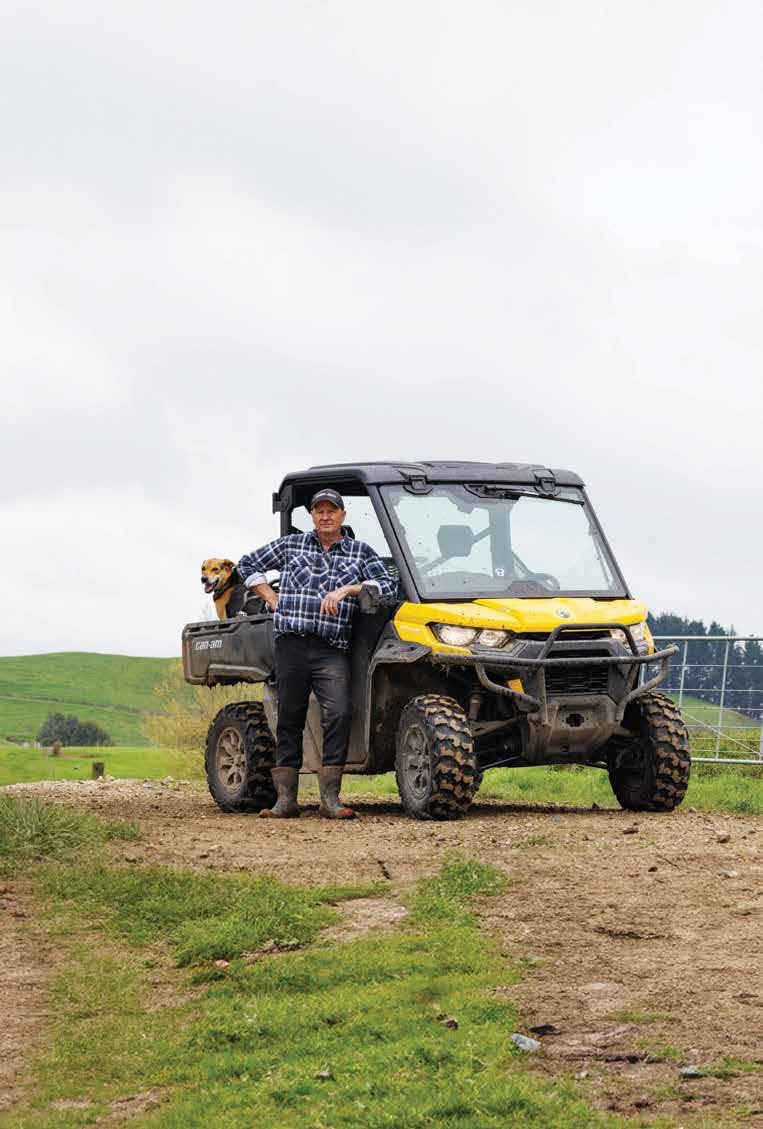
emissions.
STEVENTHANKS TO the muchneeded review of the methane science being announced, the topic of agricultural emissions is back in the discussion along with all the associated misinformation.
Groundswell NZ is taking a keen interest in this review and believes it has the potential to completely re-shape how we view agricultural
The latest science has discovered that both methane and N2O may be irrelevant as GHG’s due to water vapour’s role in climate change being grossly underestimated. Both emissions are trace gases that have an atmospheric concentration of 1.8ppm (parts per million) and 0.3ppm respectively.
There is a growing body of research which

indicates that water vapour, which has a much greater concentration of around 15,000ppm, saturate these agricultural GHGs rendering them effectively irrelevant.
Suggestions by some government agencies that the ‘science is settled’ could not be further from the truth, this review promises to be robust and enlightening.
Pre-empting the review of the science

CRANSTON is the Climate Change Commission who released their draft report on emissions reductions for the 2036 to 2040 period.


The overriding theme of their advice is that the ambition of the current targets should be maintained regardless of the developing science on methane’s warming effect. The Commission has taken the arbitrary position that any reduction in the methane target to reflect this new science would therefore require greater reductions from CO2 emitters to compensate. Commission members are attempting to ring-fence the current excessive targets by default to ensure the Commission still delivers a cooling trend by 2050.
The Commission is pushing for a 24% reduction of methane emissions by 2040; this is well above the 6% reduction needed to achieve no additional warming. Their pathway is based on the dubious assertion that dairy cow numbers can plummet 23% while not affecting total production and profitability.
ated threat that customers such as Nestle could reject our produce if further action is not taken to reduce emissions. New Zealand’s highly efficient dairy production means that Nestle would also have to reject almost the entirety of the EU’s dairy production first or risk increasing their scope 3 emissions. Contrary to Fonterra’s concerns, any customer who is seeking further emissions reductions would do well to increase their purchases of NZ dairy products.
It’s a shame that Fonterra distracts itself with baseless fear mongering as they are quietly laying the foundation of what could be a sustainable solution to emissions management. Fonterra has negotiated with Mars to deliver to them our most emissions efficient milk for a small premium. In true co-operative style the suppliers providing this premium milk don’t receive any credit for it, but this could soon change.
GOING TO THE FIELDAYS?
Better make sure farmers know where you’ll be and what you have to offer.
Rural News National Fieldays feature is the best place to prime farmers and ensure you maximise your Fieldays spend.

The Commission uses a Biological Emissions Reference Group report to support their plan but if they had read the report properly, they would know there are ‘important barriers’ limiting any significant shift towards higher per cow production.
Continuing with their typical fast and loose approach, the Commission’s draft report went on to say that they have seen ‘evidence’ that a methane inhibiting vaccine will be available by 2036. This was some revelation as the vaccine program has been floundering without any major breakthroughs for over 20 years.
The Commission had in fact misinterpreted another report which said a vaccine could take ten years after a successful prototype is developed, but gave no predictions when this successful prototype will arrive.
Not to be outdone by the increasingly irrelevant Climate Change Commission, Fonterra continued to push its unsubstanti-
Unlike with the organic market where consumers expect their organic milk to be produced on an organic farm, this doesn’t matter for low-emissions milk. Fonterra can simply select their most emissions efficient farmers from anywhere in the country and accredit their numbers to the Mars deal. This means that farmers who have systems suitable for chasing a low-emissions premium can do so, and farmers who don’t have the right infrastructure or maybe disagree with a proposed mitigation technology can simply forgo the premium.
There is no need for a heavy-handed approach from processors, both the dairy and red meats sectors have the financial tools available to incentivise low emissions production and meet their market demands. Instead of putting pressure on farmers to reduce emissions, processors should focus their efforts on generating a genuine price premium, the free-market will take care of the rest.
A FIVE-YEAR ran-
domised survey of herbicide resistance on New Zealand arable farms has found widespread high levels of resistance – with 71% of farms affected in the worst-hit region –South Canterbury.
“It’s at higher levels than we thought,” said Foundation for Arable Research (FAR) senior field officer Ben Harvey.
The survey, conducted in association with AgResearch, is the country’s first national benchmarking of the problem of herbicide resistance. Going region by region over all New Zealand’s major arable farming areas, farms were chosen at random from the FAR database. Weed seeds were collected from them, then germinated and grown, before being sprayed with a variety of herbicides, in a series of pot tests.
In South Canterbury, 71% of farms (22 out of 31) recorded at least one instance of a herbicideresistant weed. By contrast, herbicide-resistant weeds were found on only 11% of farms in the southern North Island.
Harvey said the most common type of resistance found was grass weeds, mostly ryegrasses, resistant to the sulfonylurea group of herbicides.
These are the Modeof-Action Group 2 herbicides - acetolactate synthase inhibitors such as iodosulfuron and chlorsulfuron.


The only other resistance detected was to Mode-of-Action Group 1 herbicides (Acetyl CoA carboxylase inhibitors such as haloxyfop and pinoxaden).
Group 1 herbicides are used to control grass weeds in a range of broadleaf and cereal crops. Group 2 herbicides have activity on a wide range of grass and broadleaf weeds and are also used widely in cereals.
FAR says the differences between regions are suspected to be due to differences in farming systems, with areas where crop rotation options are limited tending to have higher levels of resistance.
Other factors leading to differences in the regions may include:
Whether or not pasture is commonly included in rotations.
The prevalence of
grass seed crops, particularly ryegrass, in the rotation. Ryegrass is prone to seed shattering and was the most common herbicide-resistant weed in the survey.
Whether or not spring crops, which can disrupt weed life cycles, are commonly included in rotations.
Harvey told Rural News that South Canterbury arable farmers have quite limited options for rotation, largely because of their climate.
They generally tend to grow grass seed, cereals and oilseed rape. Some do a lot of wheat because it’s the most profitable, he said.
“If you’re growing continuous wheat, which is getting a lot rarer than it used to be, thankfully, then you’re just using the
same herbicide over and over and over.”
Harvey said that any bag of ryegrass seed would contain some individual seeds naturally carrying the genes for resistance to sulfonylureas.
When a paddock used to produce ryegrass seed was then used for another crop in subsequent rotations, ryegrass would appear as a weed – including a few plants carrying the resistance.
“And if you spray them all off with this herbicide, the ones that are resistant will survive. They’ll set seed, then the next year there’ll be 100 of them, where there was only 10 before, then the next year a thousand, and exponentially they come to dominate the weed profile.
FAR RECOMMENDED that farmers use a “robust” rotation with a lot of different types of crops.
“Last year, we plotted a trial area of linseed because that’s a different kind of crop or break crop, which you can use different herbicides in.
“I haven’t seen the results for that yet, but these are the sorts of things that we’re talking to growers down there about ways that they can just stop doing the same old thing over and over every year.”
It was also important to use full label rates.
“Don’t do a half rate because if you do have any survivors, then they’re more likely to be resistant.
“Don’t just use one type of herbicide, or use a preemerge and a post-emerge.”
Farmers should also investigate other types of weed control, such as integrated weed management.
Ben Harvey said the low levels of resistance found in the lower North Island was likely due to their long rotations, often with pasture in it. When a paddock is in pasture, grazing would mean the seeds are being eaten, and the farmer wouldn’t be using the same herbicide on it as when trying to suppress grass weeds in a cereal crop.
“They just have a different kind of farming system up there, that doesn’t rely on them being quite so intensive in the way that they do their weed control.”
Harvey said it was hard to put a dollar cost on herbicide resistance because there were so many other factors, but uncontrolled weeds was the one thing that would affect yield the most in a typical year.
Some farmers trying to get on top of difficult weeds by spraying out the bad patches with glyphosate before harvest, cutting the crop for silage instead of harvesting the wheat, or using more expensive and varied herbicides.
“One of the things that we’re recommending is that they don’t just use one herbicide, use a sequence or a mixture that are all of different kinds.”
“Continuously spraying with the same herbicide over and over again leads to these resistant populations just dominating the weed population.”
Another factor is that South Canterbury farmers tend not to use spring sowings, which can disrupt weed lifecycles.
“If you’re always sowing in autumn, which is what they do down there, then you get the same sort of weeds that like to germinate each year.”



FEMALES ARE dominating the veterinary profession worldwide and many farmers are welcoming this change in the composition of the profession, says Britain’s Chief Veterinary Officer (CVO)
Professor Christine Middlemiss.
She says one of the changes since she graduated in 1992 is the greater number of females entering the profession.
Middlemiss was in New Zealand recently to meet her fellow CVOs from NZ, Australia, Canada and the US. The CVOs keep in regular contact with each other and meet once a year for face-to-face discussions.

She says issues discussed this time included microbial resistance, a vets as well as ongoing biosecurity and animal health and welfare.
Speaking to Rural News, Middlemiss recalled that in her days as a vet, it was about a 50% male/female mix.
85% female pretty much world-wide. Everyone has different views on this, but I suspect there are more female role models and that encourages more women to see it as profession they


Because we care about your
says.
Middlemiss says nowadays there are more specialised veterinary practices than when she started off as a vet. She says practices did farm animals as well as small animals, but now people tend to choose one or the other.



FARMERS ARE being urged to make their veterinarians an integral part of their farm management team.
This is the advice of Britain’s Chief Veterinary Officer (CVO) Professor Christine Middlemiss who was in New Zealand recently for discussions with her fellow CVO’s from New Zealand, Australia, Canada and the US. The group meets once a year and NZ hosted the meeting this year.
There is clear evidence that shows that vets are trusted independent advisors and can offer a lot more than just turning up to deal with a sick animal, she adds.
“They are not just your animal health team, but they are also your business team because we can work with farmers to prevent problems occurring on farm and this makes good economic sense. They can also offer good advice around nutrition and grass management,” she says.
“What we don’t know much about is why boys are not entering the profession, after all, it’s pretty difficult to talk to them if they don’t apply,” she says.
Middlemiss says vets are also well clued up on wider issues around farming through their links to their own professional body and government and industry organisations, and having the right information is key step to making the right on-farm decision. She says the other positive that vets bring to a farming business is that their decisions and information are based on strong scientific evidence.
One somewhat puzzling statistic that Professor Middlemiss points to in the UK is that 75% of those who stopped practicing as vets did so within four years or less after graduating.




She says the whole attitude to a work-life balance and more flexibility within the workplace, and new legislation giving effect to that, is probably another reason why the veterinary profession has become more attractive to women. She says this gives women the ability to have a family and still work.
Middlemiss says it matters little if a vet is male or female – the job is about having the right skills and being able to communicate with the owners of animals. She says she was once told by one of her mentors that it didn’t matter so much about how clever you are as it was to remember that every animal has an owner and being able to communicate with them was critical.
She says when a
female vet turns up for the first time, they often get the raised eyebrow look from a farmer and a comment that the ‘girl vet has turned up’. But she adds that quickly any prejudice wears off and we get farmers specifically asking for that same ‘girl’ vet.
“I come from a farm-
ing family in Scotland and before I became a vet did quite a lot of farm work, so I know my way around livestock.
“Maybe you’re not as strong as some of the men, but you there to get the job done. And just remember I can get two hands in a cow to calve it,” she says.


MORE BULL breeders are using genetic tools according to the latest research.
One in five commercial beef farmers are now using artificial insemination and more than three quarters of commercial farmers (77%) are buying bulls from breeders that use genetic tools such as estimated breeding values, breeding indexes, artificial insemination, genomics and/or embryo transfer.
The research was done for the Beef + Lamb New Zealand-funded Informing New Zealand Beef programme (INZB).
Gemma Jenkins, programme manager at INZB, says it is encouraging to see the overall increase in awareness of INZB tools, a rise in the understanding of the numbers and science behind beef genetics and the ability to apply the genetic processes on farm, and a continued belief in the use of genetics.
“This is the third year we have
undertaken the survey and it’s evident that the industry is making progress. Breeders are confidently using genetic tools,” she says.
Ninety nine per cent of breeders surveyed are using genetic tools and the usage has grown significantly across nearly all types of genetic tools compared to 2021 and 2022.
Ninety per cent of trusted professionals and breeders are also encouraging farmers to use superior genetics. There has also been a significant increase in the number of farmers using artificial insemination, up from 11% to 20% since 2021.
“This is interesting and we’re going to explore more about why we have seen this change,” says Jenkins.
“A significant majority of the farmers responding to the survey also want to be able to compare bulls across breeds.”
The seven-year INZB partnership, supported by B+LNZ, the Ministry for Primary Industries (MPI) and the New Zealand Meat Board, aims to boost the sector’s profits by $460m over the next 25 years.
It is focused on increasing the uptake of use of genetics in the beef industry. The four main components are building a genetic evaluation and data infrastructure, progeny test herds, developing breeding objectives and indexes and developing new data sources.
The industry survey tracks changes in industry attitudes and behaviours towards beef genetics over time. An analysis of the findings and suggestions from respondents will help inform the programme.
There were 336 responses to the survey including 187 commercial farmers, 112 bull breeders and 37 influencers.
HUSTLER Equip-
ment recently unveiled the Combi RX² Series 2 multi-feeder wagon (series 2).
The Series 2 builds on the success of the Combi RX multi-feeder range, launched in 2019, that had built a reputation for its ability to feed any feed type, ease of loading and visibility.
The Combi RX brought to market a simple and unique pusher design which eliminated high maintenance chains, bars, gearboxes and the constant adjustments associated with conven-

tional feed-out wagons.
“After more than five years of invaluable market feedback from users and owners, the release of Combi RX² (series 2) will bringing a further leap in reliability, even lower maintenance
and we’ve also made it more user-friendly to operate,” said Brent Currie, CEO of Hustler Equipment.
“Whilst many of the improvements appear subtle, they all add up to another significant step
forward from its predecessor, an answer to the demands of the market.”
Building on the original Combi RX features that included versatility, chainless simplicity, a trouble-free stepless floor and load-dividing design,
the key enhancements include a wider crossfloor, removing potential crushing and jamming, while also reducing operator error.
In addition, angled front chassis rails allow for tighter turns with-
out tire-to-chassis contact, helping to improve manoeuvrability, while a new plastic bonnet and redesigned antenna enhance visual appeal and protect the FeedLink scale and feed management system from unintentional damage.
Reliability has been enhanced with an improved elevatormotor retaining system, larger pusher rams to handle heavier loads and an improved spring and sub-frame design on the RX218 for reduced greasing and wear. Additionally, improved tensioner block adjustments, a sturdier gearbox mount and improved critical bearing protection
increases the machine’s robustness. New chain guides on the cross floor improve tracking and reduce the derailing risk, while optimised hose routing reduces chafing and improves flow.
A redesigned pusher blade has reduced overall weight and increase strength, while larger diameter 20-ply tyres help increased load ratings and durability.
An optional, factory fitted, trough feeding kit features unique feedbars and a curved elevator for precise feed drop placement, making the machine suitable for ideal for trough feeding, feedpads or over-fence situations.
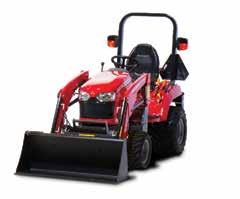


IN A move that will make harvesting operations easier, particularly in odd-shaped paddocks, Kuhn has announced that GPS section control is now available on the FC 9330 RA mower conditioner, the GA 13231, and GA 15231 four-rotor rakes.
GPS section control automates the raising and lowering of mower units (FC 9330 RA) or swathing rotors (GA 13231 / 15231) at the headland or during manoeuvres.
Automation allows the operator to
concentrate on the task of driving, and GPS section control automation will provide extra productivity during intensive work, at peak season, or when operating in restrictive or wedge-shaped fields.
Manual control of the machine is still possible via the control terminal or the ISOBUS CCI A3 joystick. The FC 9330 RA and GA 13231/15231 machines are compatible with ISOBUS CCI 800 and 1200 terminals for section control by GPS but also for use with other ISOBUS terminals.







JOHN DEERE has expanded its repair and replacement part offerings, with the Vapormatic brand officially added to its range of ‘Alternative Parts’ in New Zealand.
A subsidiary of John Deere, UK-based Vapormatic has served the agricultural industry for more than 70 years exporting a range of more than 30,000 tractor and agricultural machinery parts and accessories to 90 countries.
The addition bolsters John Deere’s Alternative Parts offering, with JD Australia and New Zealand director of aftermarket and customer support, Emma Ford, commenting: “These parts have been manufactured to fit John Deere equipment and are priced at a lower cost than genuine John Deere parts, while still giving customers peace of mind they are backed by a 12-month warranty. Adding Vapormatic to the range helps provide more repair solutions for customers no matter their budget. With challenges like increased production costs, it’s important we provide a wide range of parts to suit all budgets and repair scenarios.”
John Deere’s full range of parts include Genuine, Reman (or remanufactured) and Alternative. Genuine parts are built specifically for John Deere machines, meaning they are identical to the new parts fitted at the factory. Remanufactured parts feature components which have been replaced or remanufactured to deliver like-new performance at a lower cost than brand new parts. They have undergone extensive testing by factory engineers to ensure they meet or exceed original performance specifications.
As the name suggests, Alternative Parts are an economical, alternative choice which will still deliver the performance and reliability expected of John Deere parts.
“Expanding our Alternative Parts offering with the addition of Vapormatic is part of our commitment to offering our customers the right part at the right price,” says Ford. “Customers who want to find out more about the range of parts designed for John Deere equipment, should contact their local dealership.”


